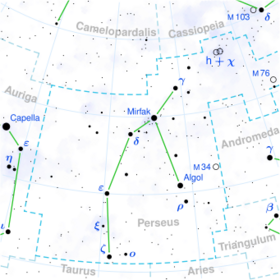Xi Persei
Topic: Astronomy
 From HandWiki - Reading time: 4 min
From HandWiki - Reading time: 4 min
| Observation data Equinox J2000.0]] (ICRS) | |
|---|---|
| Constellation | Perseus |
| Right ascension | 03h 58m 57.90229s[1] |
| Declination | +35° 47′ 27.7132″[1] |
| Apparent magnitude (V) | 4.04[2] |
| Characteristics | |
| Spectral type | O7.5III(n)((f))[3] |
| U−B color index | −0.93[2] |
| B−V color index | +0.02[2] |
| Variable type | slightly variable[4] |
| Astrometry | |
| Radial velocity (Rv) | 65.40[5] km/s |
| Proper motion (μ) | RA: 3.62[1] mas/yr Dec.: 1.74[1] mas/yr |
| Parallax (π) | 2.62 ± 0.51[1] mas |
| Distance | approx. 1,200 ly (approx. 380 pc) |
| Absolute magnitude (MV) | −5.50[3] |
| Details | |
| Mass | 26[3]-36[6] M☉ |
| Radius | 14[6] R☉ |
| Luminosity | 263,000[3] L☉ |
| Surface gravity (log g) | 3.5[3] cgs |
| Temperature | 35,000[6] K |
| Rotational velocity (v sin i) | 220[3] km/s |
| Age | ~7[7] Myr |
| Other designations | |
| Database references | |
| SIMBAD | data |
Xi Persei (ξ Persei, abbreviated Xi Per, ξ Per), known also as Menkib /ˈmɛŋkɪb/,[8][9] is a star in the constellation of Perseus. Based upon parallax measurements taken during the Hipparcos mission, it is approximately 1,200 light-years from the Sun.
Nomenclature
ξ Persei (Latinised to Xi Persei) is the star's Bayer designation.
It bore the traditional name Menkib, Menchib, Menkhib or Al Mankib, from Mankib al Thurayya (Arabic for "shoulder" [of the Pleiades]). In 2016, the International Astronomical Union (IAU) organized a Working Group on Star Names (WGSN)[10] to catalogue and standardize proper names for stars. The WGSN approved the name Menkib for this star on 12 September 2016 and it is now so included in the List of IAU-approved Star Names.[9]
In Chinese, 卷舌 (Juǎn Shé), meaning Rolled Tongue, refers to an asterism consisting of Xi Persei, Nu Persei, Epsilon Persei, Zeta Persei, Omicron Persei and 40 Persei.[11] Consequently, the Chinese name for Xi Persei itself is 卷舌三 (Juǎn Shé sān, "the Third Star of Rolled Tongue").[12]
Properties
Xi Persei has an apparent magnitude of +4.06 and is classified as a blue giant (spectral class O7.5III). It is intrinsically 12,700 times brighter than the Sun with absolute magnitude −5.5 in the V band. If the ultraviolet light and light from other wavelengths that emanates from Menkib is included, its total bolometric luminosity is 263,000 times that of the Sun.
The star has a mass of some 30 solar masses and a surface temperature of 35,000 kelvins, making it one of the hottest stars that can be seen with the naked eye. The fluorescence of the California Nebula (NGC 1499) is due to this star's prodigious radiation.[7] It is a member of the Perseus OB2 association of co-moving stars, but may be a runaway star since it is now separated by 200 pc from the association's center and has an unusually high radial velocity.[13]
References
- ↑ 1.0 1.1 1.2 1.3 1.4 Van Leeuwen, F. (2007). "Validation of the new Hipparcos reduction". Astronomy and Astrophysics 474 (2): 653–664. doi:10.1051/0004-6361:20078357. Bibcode: 2007A&A...474..653V.
- ↑ 2.0 2.1 2.2 Ducati, J. R. (2002). "VizieR Online Data Catalog: Catalogue of Stellar Photometry in Johnson's 11-color system". CDS/ADC Collection of Electronic Catalogues 2237: 0. Bibcode: 2002yCat.2237....0D.
- ↑ 3.0 3.1 3.2 3.3 3.4 3.5 Repolust, T.; Puls, J.; Herrero, A. (2004). "Stellar and wind parameters of Galactic O-stars. The influence of line-blocking/blanketing". Astronomy and Astrophysics 415 (1): 349–376. doi:10.1051/0004-6361:20034594. Bibcode: 2004A&A...415..349R.
- ↑ Ramiaramanantsoa, Tahina; Moffat, Anthony F. J.; Chené, André-Nicolas; Richardson, Noel D.; Henrichs, Huib F.; Desforges, Sébastien; Antoci, Victoria; Rowe, Jason F. et al. (2014). "MOST detects corotating bright spots on the mid-O-type giant ξ Persei". Monthly Notices of the Royal Astronomical Society 441 (1): 910. doi:10.1093/mnras/stu619. Bibcode: 2014MNRAS.441..910R. https://pure.uva.nl/ws/files/2434272/160389_MOST_detects_corotating_bright_spots.pdf.
- ↑ Gontcharov, G. A. (2006). "Pulkovo Compilation of Radial Velocities for 35 495 Hipparcos stars in a common system". Astronomy Letters 32 (11): 759–771. doi:10.1134/S1063773706110065. Bibcode: 2006AstL...32..759G.
- ↑ 6.0 6.1 6.2 Krticka, J.; Kubat, J. (2010). "Comoving frame models of hot star winds. I. Test of the Sobolev approximation in the case of pure line transitions". Astronomy and Astrophysics 519: A50. doi:10.1051/0004-6361/201014111. Bibcode: 2010A&A...519A..50K.
- ↑ 7.0 7.1 Hoogerwerf, R.; De Bruijne, J. H. J.; De Zeeuw, P. T. (2001). "On the origin of the O and B-type stars with high velocities. II. Runaway stars and pulsars ejected from the nearby young stellar groups". Astronomy and Astrophysics 365 (2): 49. doi:10.1051/0004-6361:20000014. Bibcode: 2001A&A...365...49H.
- ↑ Davis, George A. (1944). "The pronunciations, derivations, and meanings of a selected list of star names". Popular Astronomy 52: 8–30. Bibcode: 1944PA.....52....8D. http://adsbit.harvard.edu/full/1944PA.....52....8D.
- ↑ 9.0 9.1 "Naming Stars". IAU.org. https://www.iau.org/public/themes/naming_stars/.
- ↑ IAU Working Group on Star Names (WGSN), International Astronomical Union, https://www.iau.org/science/scientific_bodies/working_groups/280/, retrieved 22 May 2016.
- ↑ (in Chinese) 中國星座神話, written by 陳久金. Published by 台灣書房出版有限公司, 2005, ISBN:978-986-7332-25-7.
- ↑ (in Chinese) 香港太空館 - 研究資源 - 亮星中英對照表 , Hong Kong Space Museum. Accessed on line November 23, 2010.
- ↑ Lesh, J. R. (September 1969). "Internal motions in the associations II Per and I Lac.". Astronomical Journal 74: 891–898. doi:10.1086/110878. Bibcode: 1969AJ.....74..891L.
External links
 |
 KSF
KSF
